The Inner Lives of Fish
Air Date: Week of December 8, 2017
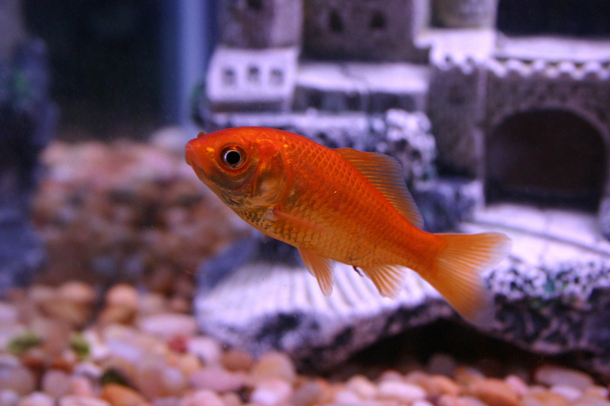
Fish are smarter than you might think – and they can get depressed like people. (Photo: Kai Schreiber, Flickr CC BY-SA 2.0)
Aquatic creatures seem so different from us it is easy to think they don’t think. But Culum Brown, who studies fish cognition and teaches at Macquarie University in Sydney, Australia, says some fish are actually pretty smart, exhibiting complex social behaviors, navigation skills, and even tool use. Prof. Brown tells host Steve Curwood how pharmaceutical companies are using zebra fish to develop antidepressants, and how we can keep the fish in our home aquariums happy and healthy.
Transcript
CURWOOD It’s Living on Earth, I’m Steve Curwood.
In the Disney Pixar film “Finding Nemo,” when little Nemo is caught and taken to a fish tank in a Sydney dentist’s office, he meets a fish named Gill, who dreams only of making it out to the Big Ocean.]
[AUDIO FROM “FINDING NEMO”]
GILL: My first escape, landed on dental tools. I was aimin’ for the toilet.
NEMO: Toilet?
GILL: All drains lead to the ocean, kid.
NEMO: Wow. How many times have you tried to get out?
GILL: Ah, I’ve lost count. Fish aren’t meant to be in a box, kid. It does things to ya’.
[SOUND OF BUBBLES]
OTHER FISH: BUBBLES!! BUBBLES, BUBBLES.
CURWOOD: Well, “Finding Nemo” may not be so far-fetched, as scientists claim that fish brains are complex and really quite like ours. In fact, human antidepressant medications are being tested on zebra fish.
Culum Brown teaches Sat Macquarie University in Australia and studies fish cognition. He joins me now from Sydney. Welcome to Living on Earth.
BROWN: Ahh, thank you. It's great to be here.
CURWOOD: So, why do species like the Zebrafish make good models for humans and testing new anti-depressant medications?
BROWN: Yeah, so I guess the first thing that the whole pharmaceutical companies caught onto was the fact that waste pharmaceuticals, after we've used them... Obviously we take medicine, we don't fully metabolize all the medicines we take. Most of them end up going down our sewerage system, and our modern sewerage plants just aren't set up to deal with pharmaceuticals, and probably 10 or so years ago people started recording high levels of all sorts of pharmaceuticals in runoff and indeed in things like Sydney Harbor and some of the major ports. And then it became pretty apparent that those things were having effects on the behavior of the animals living in those environments, including the fish. The genetic components and the underlying physiology, neurotransmitters, and all those sorts of things, are highly conserved across all vertebrates, so everything from fish to humans basically have a shared physiology.

Pharmaceuticals such as antidepressants often end up downstream of water treatment plants, which can’t remove them, and have been found to change fish behavior in places like Sydney Harbour. (Photo: Bernard Spragg. NZ, Flickr Public Domain)
That means that all those antidepressants that are specifically designed to manipulate human behavior also manipulate fish behavior in very similar ways. That's really how it started, and then of course the pharmaceutical companies soon realized that, well, “Why are we spending all this money on rats? You know, for every rat we have in an animal house somewhere we could have 50 Zebrafish,” and so they basically shifted their models system from rats to studying Zebrafish. And Zebrafish for a long time have been used in captivity because we can manipulate the genes and breed all sorts of different mutant lines of Zebrafish. They're a really fascinating model system.
CURWOOD: So, how do you test the anti-depressant in the Zebrafish? I mean, how do you know they're depressed to begin with?
BROWN: Well, of course, the first thing you need to know about recognizing depression is that you have to know what normal behavior looks like in animals and indeed in humans. When you are looking for signs of depression, they're actually very similar. The fish tends not to engage with the outside world and they tend to sort of mope around in the corner. Their activity levels tend to go down and all those sorts of things. And then, of course, you dose them, and you dose them at specific rates and various therapeutical levels. Their behavior starts to change.
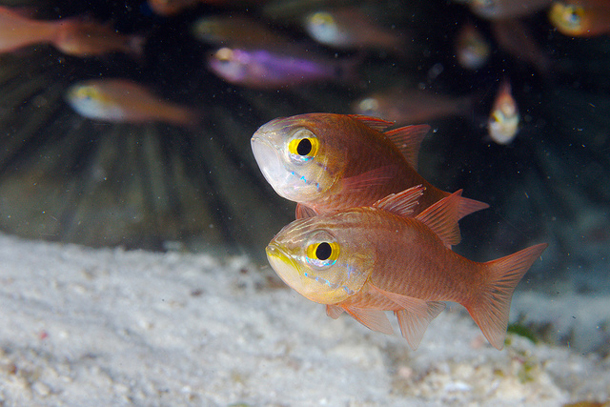
Many fish are social creatures, living in schools together and learning essential behaviors from one another. (Photo: Klaus Stiefel, Flickr CC BY-NC 2.0)
And if you look at something like an antidepressant, what it tends to do is it dulls anxiety and excitement but it does it in both ways, so the fish never get really excited when they should. So, for example if you have two males that might be ordinarily highly aggressive when they see each other, they tend not to be as aggressive. And similarly if fish are exposed to something that might be scary or terrifying for them, some sort of shock or something like that or a predator, they also tend to have very limited response to predators and those sorts of situations as well. So, it tends to produce a very even behavior, very boring. They don't really respond to external cues in the way that they should.
CURWOOD: So, what kind of research have you done on fish cognition?
BROWN: So, my background really is, it started off as looking at predator recognition and avoidance responses. I was very much interested in conservation biology and restoring natural populations in the wild, and there are many examples where animals are moved around the environment, and for example, predators move from one habitat to another, and they tend to wipe out all sorts of local native species, and that happens in fish a lot. And I was looking at how we can use learning and memory to retrain them to recognize predators, with the hope of releasing effectively smart fish back into the wild to cope with predators, and that was during my honors in PhD a long time ago, 20 years ago, and I've been studying all sorts of aspects of intelligence in fish, since.
CURWOOD: Culum, how do people respond when you told them that, well, you kind of study the psychology of fish.
BROWN: [LAUGHS] Yes, so there are all sorts of cartoons of me having a fish on the couch in my office and asking questions like, "How does that make you feel?"
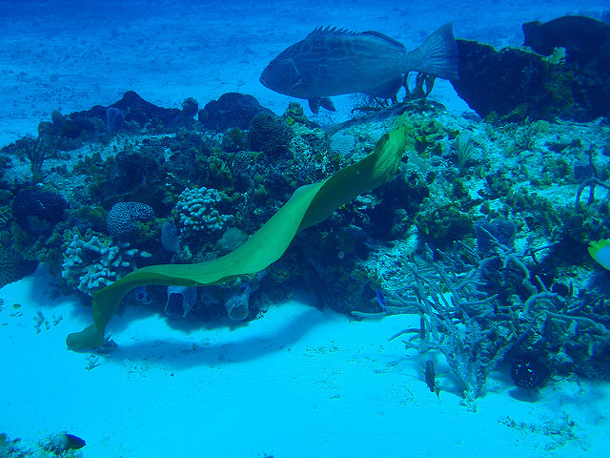
A black grouper and green moray eel engage in cooperative hunting. (Photo: Andy Blackledge, Flickr CC BY 2.0)
CURWOOD: So, to what extent do fish have societies? I'm told that Groupers especially seem to be social.
BROWN: Yes, I think people forget about just how social fish can be, and there's this theory that tries to explain why humans are as smart as they are, and it has to do with social intelligence. It's called the Social Intelligence Hypothesis, and it was originally coined to explain why humans, and indeed primates, are smart, and the idea is that you have these complex social interactions, you need to be fairly brainy to keep track of all those interactions, you know, who's the boss and who's not, and who's interacting with who, and all those sorts of things.
But, you know, humans and primates aren’t the only ones that spend a lot of time in social groups, and obviously flocks of birds are pretty well known, and indeed schools of fish are a pretty standard issue. If you're thinking about fish, you often think of a school of fish. So, fish are very social.
Many species have highly complex social interaction,s and it happens not just within species, but it can also happen between species, and this is some really nice work looking at Groupers interacting with Moray eels and soliciting joint foraging trips out into the coral reef and the Grouper goes across the surface of the coral reef and the eel moves between the spaces of the coral reef, and between the two of them there's really no place for the prey to hide.
CURWOOD: [CHUCKLES] I imagine the eel can go down into the little crevice and then spook whatever's hiding in there, and then [MAKES THE SOUND OF QUICKLY SLURPING UP FOOD.] the Grouper has it.
BROWN: Right, and the same thing happens is the Grouper is cruising along the top, all the fish duck down into the coral to hide and, well, straight into the path of the of the eels. So, when they work together, synergistically the outcomes for both of them is much higher than if they're just working by themselves.
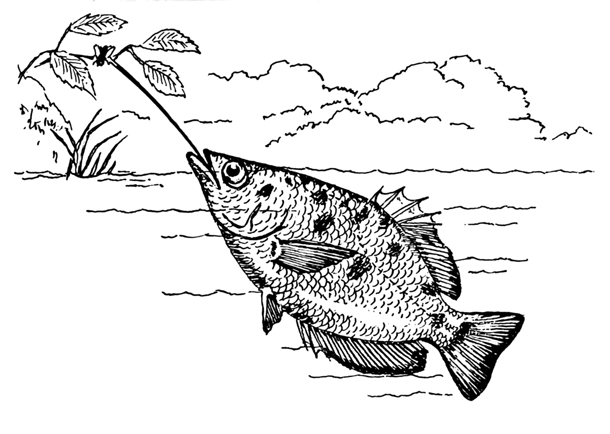
A diagram of an archerfish shooting a jet of water at an insect to capture it when it falls. (Photo: Pearson Scott Foresman, Wikimedia Foundation creative commons)
CURWOOD: So, how do they do high five? One fin to a...
BROWN:[LAUGHS] Possibly. They certainly do some weird body shakes and various things to communicate to each other.
CURWOOD: So, talk to me about some examples, some more examples of what's going on that meets the eye when it comes to some species of fish.
BROWN: Yeah, so, I mean we just talked about social intelligence, and just like you and I, if a fish gets a choice between an unknown fish on one side and perhaps a group of known fish on the other, they will nearly always choose to hang out with the fish that is familiar with them. So, just like if we go to a party, we don't usually hang out with a bunch of strangers, when we tend to gravitate towards the people we know and interact with them. And fish will do the same thing. They can recognize themselves and other individuals.
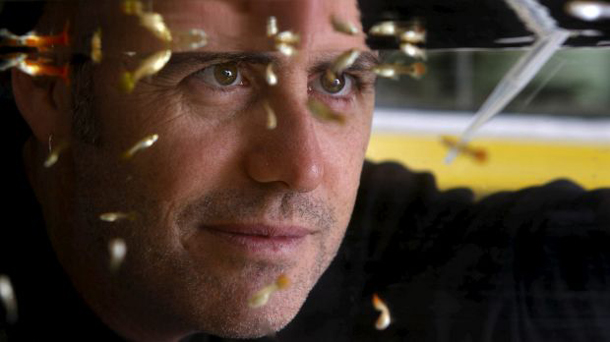
Culum Brown studying guppies. (Photo: courtesy of Culum Brown)
And one of the species we work in is an Intertidal Gobi, and it's found in the same rock pool week after week after week. And if you pick them up and move them 50 or 100 meters down the rock platform, they come back the next day. So, they have really amazing homing capabilities, and the shark species that we work on migrate, you know, 1,500 kilometers or more and come back to exactly the same reef every year, year after year after year.
Of course, there are lots of other components of cognition that we study, and you know I've recently written a review on tool use in fishes which again was one of those things that we used to think was unique to people, but the more we learn about it, the more we find that there are fishy examples.
CURWOOD: Wait a second. You're talking about fish using tools? What kinds of tools do fish use?
BROWN: [LAUGHS] Yeah, so, one of the problems with the definition of tool use, of course, is this was actually originally coined to explain tool use in primates. Of course, primates are very similar to humans. And primates and humans tend to use their hands to manipulate tools. Of course, fish don't have hands, but what they do have are the aspects of the environment that they can use. They're very well known for manipulating water, for example, so Archerfish can basically generate a water pistol that they sit at the surface of the water, and they shoot insects above the surface of the water, and the insects fall to the surface of the water and they grab them as they fall down, and their marksman skills are second to none. It's just incredible, and that's not something they do automatically. It's something they have to learn as they grow and develop so their skills improve.

A goby swims through a maze designed to test spatial learning skills. (Photo: courtesy of Culum Brown)
CURWOOD: OK, Culum, how should we be treating fish to provide for their mental health needs?
BROWN: You know, for a long time in many zoos around the world, the old school zoo was basically a concrete pen in which the animal was placed, and it soon became apparent that the animals started doing unusual behaviors. They certainly weren't behaving normally. They would do things like, you know, pace around the enclosure, rock back and forth and all those sorts of things. And it soon became apparent that that was a response to a lack of environmental enrichment. There was nothing for them to respond to or react to or, and so their behavior becomes abnormal in captivity.
And so zoos, particularly in the last 10 to 15 years, really started to concentrate on making the enclosures more like the real world. They planned it out. They start introducing little caches of food around the place so the animal actually has to forage and find food and things like that, and that sort of enrichment has a really big impact on the behavior of the animal in captivity. And it's really only maybe the last 10 years I suppose that we started thinking about exactly the same approach but in fishes, that if you increase the complexity of the environment that these animals are living in, there are all sorts of benefits in terms of regenerating natural behaviors.
And in fact, not only is their behavior returning to normal and becoming more sophisticated, their brain is remodeled as well. Their brain has more connections, it tends to get bigger, and so that's the sort of thing we like to see. It's great from an animal welfare perspective, but it also has really positive conservation biology outcomes because many fish around the world are reared in captivity and then released into the wild to try and bolster natural populations, and of course if you don't have that kind of enrichment when they're reared then their behavior when they're released is completely wrong, and they die really quickly.
CURWOOD: So, somebody listening to us who has an aquarium at home and cares a lot about the fish. What can they do to make the fish feel happier?
BROWN: Yeah, of course fishes are in fact the most numerous pet in the world, so in terms of the numbers of pets, fish are by far and away more popular than cats and dogs and anything else. So, much the same way you wouldn't keep your dog in a boring cupboard, or your cat for that matter, you shouldn't really keep the fish in an empty, boring aquarium or a goldfish bowl. In fact, in some countries around the world, goldfish bowls are banned for animal welfare reasons.
Really, what you want is a reasonable size volume of water to start with. If you don't have a good volume of water, then just maintaining water chemistry becomes more difficult. But also, in terms of the space for the animals to move around, you really want the animal to be active just in the same way that you see an enclosure in a zoo. It's got lots of physical structure for the animal to interact with. If you can feed the animal live foods and things like that, then that obviously is a great thing. And even hide bits of food in the aquarium, move things around, occasionally introduce a new rock or a new plant or something just to keep it interesting, but the main thing is to keep it complex, both socially and physically.
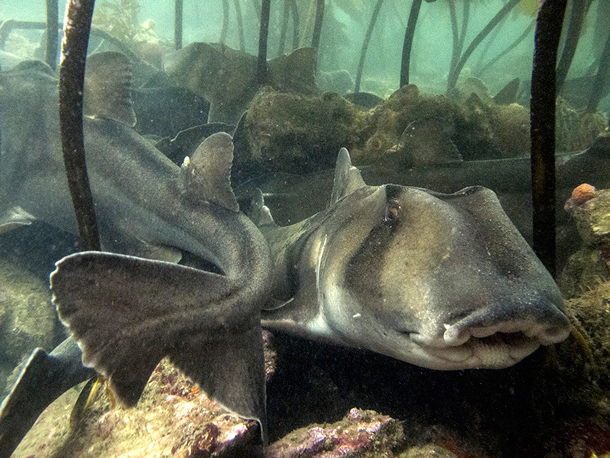
In Port Jackson, which includes Sydney Harbour, Culum Brown and his team study shark social networks and long distance migration. (Photo: courtesy of Culum Brown)
So there are a number of fish as we mentioned earlier that are social, and they won't do very well by themselves and so you might be better off buying two or three or four of a single species so they can interact and have social interactions and meaningful interactions. All these sorts of things will increase the complexity of their lives, and it will just make your aquarium look better and the fish more interesting to watch.
CURWOOD: Culum Brown is an Associate Professor at Macquarie University in Sydney, Australia, where he leads its fish lab. Thank you so much for taking the time with us today.
BROWN: It’s been a pleasure.
Links
The Behaviour, Ecology and Evolution of Fishes Laboratory at Macquarie University
Living on Earth wants to hear from you!
Living on Earth
62 Calef Highway, Suite 212
Lee, NH 03861
Telephone: 617-287-4121
E-mail: comments@loe.org
Newsletter [Click here]
Donate to Living on Earth!
Living on Earth is an independent media program and relies entirely on contributions from listeners and institutions supporting public service. Please donate now to preserve an independent environmental voice.
NewsletterLiving on Earth offers a weekly delivery of the show's rundown to your mailbox. Sign up for our newsletter today!
 Sailors For The Sea: Be the change you want to sea.
Sailors For The Sea: Be the change you want to sea.
 The Grantham Foundation for the Protection of the Environment: Committed to protecting and improving the health of the global environment.
The Grantham Foundation for the Protection of the Environment: Committed to protecting and improving the health of the global environment.
 Contribute to Living on Earth and receive, as our gift to you, an archival print of one of Mark Seth Lender's extraordinary wildlife photographs. Follow the link to see Mark's current collection of photographs.
Contribute to Living on Earth and receive, as our gift to you, an archival print of one of Mark Seth Lender's extraordinary wildlife photographs. Follow the link to see Mark's current collection of photographs.
 Buy a signed copy of Mark Seth Lender's book Smeagull the Seagull & support Living on Earth
Buy a signed copy of Mark Seth Lender's book Smeagull the Seagull & support Living on Earth

